Jul 5, 2024
Tenses
Present simple
This is perhaps the most well-known tense, especially if you are just starting to learn English. The present simple tense simply uses the subject + base form of the verb in its structure. This, however, changes when using the third person singular (he/she/it). When we use these three subjects, we add the letter ‘s’ onto the end of the base verb.
I clean my house every weekend.
He cleans his house every weekend.
See the difference?
Spelling and the third person singular rule
There are also exceptions to the adding an s to the third person singular rule.
You must add –es instead of just s if the base form ends in -s, -z, -x, -sh, -ch, or the vowel o.
miss + es = misses Rufus misses Polly so much.
do + es = does She does everything I suggest.
If the base form ends in consonant + ‘y’, remove the ‘-y’ and add ‘–ies’:
marry –> marries He marries his childhood sweetheart tomorrow.
worry –> worries My grandmother worries about me.
Irregular verbs
Two very common irregular verbs that you already know do not follow the rules above (although their third person singular present forms do actually end in –s):
be –> is
have –> has
This sounds a lot more complicated than it actually is, but believe me, once you understand these rules, the present simple is easy to use.
The uses of the present simple
1) Facts and things that are always true
The sun always shines.
Rain is wet.
2) Things that are true in the present
I live in Chicago.
He plays the piano.
3) Habits in the present
I get up at 6am every day.
Lisa does yoga on Saturdays.
Side note: when we have a fixed, long-term schedule for one day of the week, we pluralise it. For example, instead of saying Lisa does yoga on Saturday we add an ‘s’ so the listener understands it’s every Saturday.
4) Scheduled events in the future
The film starts at 20.00.
The bus leaves at 12.00.
5) For instructions and directions
Put the cake in the oven for 20 minutes.
Turn left to get to the park.
Present continuous
The present continuous tense is made up of subject + verb be + -ing verb. A gerund is a verb with ing at the end of it. Like in the present simple tense, the present continuous changes depending on the subject.
For the subject I, we use am, for the subjects you/we/they, we use are, and for the subjects he/she/it, we use is. This is also known as the present progressive.
Uses of the present continuous tense
1) When you are doing something at the time of talking
I am eating my dinner now.
Wendy is talking to the clients that have arrived.
2) When you are doing something in the general present time that is not yet a completed action
Ian is learning Spanish because he is moving to Spain.
My friends are building a hotel. Hopefully, by the end of next week, it will be finished.
3) For progress
Scott is feeling a lot better now after he took his medicine.
Mia’s English is getting better day by day.
4) For changes happening now
Summers are lasting longer and longer.
The world’s population is rising.
5) For fixed plans in the future
Dan is going to France in July.
Sharon is meeting Tracy at 4pm.
The present perfect simple
The present perfect simple tense is a fun one as it is usually used to focus on life experiences. The base structure of this tense is subject + the verb have + the past participle form.
Before reading the use and form of the present perfect simple tense, you must know that the verb go has two past participles: been and gone.
Gone is used for one-way situations, meaning when you have travelled and not yet returned. Been is used for when you have travelled somewhere and returned. Keep this in mind for all perfect tenses where the past participle is used.
The use of the present perfect simple
1) For life experiences
I have been to China twice.
Sally has dived.
Side note: We often use the past simple to add extra information. For example, Sally has dived, turns into, Sally has dived. She went when she was 18 with her then-boyfriend.
2) For past actions that have a result in the present
I have lost my purse (I lost it in the past and don’t have it now).
Duncan has forgotten Camilla’s present (he forgot it is the past and doesn’t have it now).
3) With today/this morning/this afternoon/this evening when they are not yet finished
I have drunk five glasses of water this morning.
Mike has eaten 10 biscuits this afternoon.
4) Actions that started in the past and are not finished
Pete has worked in IT for 40 years.
They’ve celebrated their birthdays in Venice since they were 12.
Side note: for this use we use for and since a lot. For is used with the amount of time i.e for one year, for two days. Since is used to say when something started i.e. since school, since 1989.
The present perfect continuous
The present perfect continuous tense is used mainly for an action that starts in the past and continues in the present. The base form of its structure is subject + the verb have + been + -ing verb.
The uses of the present perfect continuous tense
1) For an activity that has just stopped or recently stopped
Pamela is tired. She has been running in the park.
My clothes are dirty because I have just been cleaning the bathroom.
2) An unfinished action that started in the past and continues to the present
I have been writing this book all morning.
Andrew has been living in Scotland for three years.
Side note: the verbs live and work can be used in both the present perfect continuous and present perfect simple with the words for or since and have little difference in meaning.
For example, I have lived in Brooklyn for 9 years and I have been living in Brooklyn for 9 years have the same meaning.
3) Temporary actions or habits that started in the past
Sue has been drinking less lately.
Mohammed has been going to the gym more frequently.
We can use the words frequently, lately or recently to add more meaning to this use.
Past simple
The past simple only has one use in English: to describe actions that finished before the present time. The structure is subject + past tense verb.
The past tense is used a lot for history
The use of the past simple
1) Finished actions before now
I went to school today.
Clive had three sausages for breakfast.
Past continuous
The past continuous is used for actions that are ongoing in the past. The base structure is subject + past verb be + -ing verb.
The uses of the past continuous
1) Opening a story
I was studying in Rome when I saw….
Many years ago, Karen was looking out of her window.
2) Action in progress at a certain point in the past
She was eating last night.
Sinead was driving to her mum’s house yesterday morning.
3) Actions that continue in the past over a long period of time
The cat was hanging out with the neighbour’s cat for the entire night last night.
Robyn was rehearsing for her show all day yesterday
4) Continuous actions in the past interrupted by another action
I was walking in the park when a dog bit my leg.
A dog bit my leg while I was walking in the park.
For this use, it is common to use the words when and while and a combination of the past continuous and the past simple. The past simple is usually used for the shorter action.
Normally when making a phrase like this, the past simple comes after when or before while and the past continuous comes before when or after while, like in the examples above.
The past perfect simple
The past perfect simple tense is used in English to demonstrate an action that happened before another action in the past. Think of it as the past past. Its base structure is subject + had + past participle form.
The uses of the past perfect simple tense
1) Describing an action before the recent past if there are two actions
I had finished the work by the time my boss had entered.
When Cassandra died, her and Bert had been married for nearly 50 years.
He had drunk a coffee before he got ill.
The earlier action is in the Past Perfect Simple.
The past perfect continuous
The past perfect continuous tense shows that an action in the past continues up until another time in the past. The base structure for this is subject + had + been + -ing verb.
The uses of the past perfect continuous tense
1) An action that continues up until a point in the past
They had been playing tennis before it started to rain.
It had been raining, so the clothes were wet.
Future tenses in English
The very last section of the 12 tenses is the futures section. As per the table at the start of the article and the other tenses, it is divided into simple, continuous, perfect simple and perfect continuous.
The future simple
The future simple tense or simple future tense is primarily used for actions at a time later than now. The base structure is subject + will + base verb.
Please be aware that you do not add an s to the base verb if using the third person singular. For example, he will sings is incorrect but he will sing is correct.
Singapore is a very futuristic city
The uses of the Future Simple tense
1) For a spontaneous decision
He will close the window if you are cold.
I am hungry. I will make a sandwich.
Side note: please be aware that we do not use the Future Simple tense when talking about plans. We use the Present Continuous for this.
2) For predictions without evidence
I think it will rain tomorrow, even though I have not checked the weather forecast.
Pete got his palm read, and the person doing it said he will be a millionaire.
3) To express a decision made at the moment of speaking
I’ll wash the dishes!
Sandra will call Mike.
4) For promises
Harry promises he will be on his best behaviour.
Kulwinder’s cooking will not disappoint you.
5) When you give orders
You will do your homework!
Alan, you will listen to this!
The future continuous
The future continuous tense (also known as the future progressive tense) is probably the least used of the tenses in English. Why? Because it is fairly surreal.
It is used to project yourself into the future by saying a future action or future event will be in progress at a later time. Of course, no one really knows what the future has in store and this is why it leads to some confusion with even native speakers.
However, we still use it from time to time. The base structure of the tense is subject + will + be + -ing verb.
The uses of the future continuous tense
1) To express actions happening now that will continue in the future
I will still be teaching in thirty years.
In three hours, he will still be working.
Please note, we use this with the word still.
2) To project ourselves to a certain time in the future
In two hours, I’ll be a millionaire.
Rita will be snorkelling in Thailand in two weeks.
3) To politely ask something
Will Rob be joining us for dinner?
Will Maria be attending the wedding?
The future perfect simple
This tense, like the future continuous tense, is used for projecting, but you have to imagine you are looking back at yourself. It is commonly used for goals. The base structure is subject + will + have + past participle form.
Uses of the future perfect simple tense
1) Projection into the future
I will have been here for a year on the 4th of June.
Will he have eaten when he arrives?
2) Future goals and ambitions
Kerry thinks she will have been promoted by this time next month.
In five years, I will have climbed the ranks of this company and become CEO.
The future perfect continuous
This tense too projects us into the future and makes us look back at ourselves. However, the key difference is that it refers to actions that will not yet be completed at a certain time in the future.
The base structure is: subject + will have been + ing form.
The uses of the future perfect continuous tense
1) For things we will still be doing in the future
Next year I will have been working here for five years.
In two weeks’ time, I will have recovered fully from my fall.
What does teach mean?
Teach, as defined by the Oxford Dictionary, means to help someone learn something by giving information about it. It is the present simple form.
Take for instance your teacher at school or professor at university. They teach you things.
When used in its Present Simple, teach has two forms – teach and teaches.
We use teach when we use the subjects I, you, we, they.
I teach Steven how to play the guitar.
They teach your sister volleyball.
When you use it in the third person singular (he, she, it), you add es to the end, like in these examples.
He teaches children maths every Saturday.
She teaches adults English.
The pronunciation of teach is tiːtʃ and the pronunciation of teaches is tiːʧɪz.
Now we have clarified that, do you feel ready to learn more about its past form?
The past of teach
The past of teach is taught. Teach is an irregular verb and because of that, so is its past form. In writing, it has the letter g in it. But we all know by now that when you write something in English, it is not necessarily how you say it.
We pronounce the word taught like this: tɔːt.
You have to imagine it has an ort at the end of it rather than an aught.
It is also important to remember that irregular verbs do not end in ed so you should never say teached.
This is incorrect.
Taught is used in past simple sentences, present perfect sentences and past perfect sentences. It is used as the past simple verb and the past participle. Let’s take a closer look at some examples below.
Past simple and taught
As mentioned above, the past form of teach is taught. We use it for things that people teach us in the past. For example:
I taught Matthew how to ride a scooter.
My father taught me a lot of French words.
His grandfather taught him to knit.
Remember, when we are using taught in the past in a negative sentence we use this formula:
subject + didn’t + teach.
The base form makes an appearance here rather than taught. For example:
I didn’t teach Matthew that word; John did.
Mrs Myers didn’t teach Bev Latin; my sister Helen did.
When using a negative sentence in the past simple form, always use the base verb.
Present perfect and taught
The past participle of teach is taught so naturally, we use it in the present perfect tense too.
The formula for affirmative sentences is this: subject + have/has + taught.
I have taught him the alphabet.
She has taught him since she was three.
The formula for negative sentences is: subject + haven’t/hasn’t +taught.
I haven’t taught them piano.
Charlotte hasn’t taught her dogs well.
When we use the perfect tenses in a negative form, we do not transform the past participle back to the base verb as with the past simple.
Past perfect and taught
The same rules for using taught apply in past perfect tense as the present perfect tense. We do not use the base verb teach in a negative sentence, and we use it after the verb had.
For affirmative sentences, we use this formula: subject + had + taught.
He had taught me Mandarin.
They had taught Peter how to fly a kite.
For negative sentences, we use this formula: subject + hadn’t + taught.
I hadn’t taught Mary before.
We hadn’t taught Phil.
Words with silent letters in English
Hello lovely students! Today we’re going to be learning all about silent letters, and just to warn you, there are so many English words with silent letters. I’m talking about numerous amounts.
But hey, I’m here to teach you the key ones with all the letters from A to Z.
So without further ado, let’s take a look at the numerous words with silent letters in English in the comprehensive list below and why they are essential to learn.
Let’s get started.
Why are silent letters important to know?
English is a complex language for pronunciation. There are no two ways about it. Therefore knowing silent letters will help you out so much. How? Well, firstly, they’ll help you distinguish between homophones.
Homophones are words that are pronounced the same but have a different meaning and often a different spelling. Take ‘be’ and ‘bee‘ or ‘see’ and ‘sea‘. They are entirely different.
Silent letters also help us to take a look at word origin. There are plenty of loanwords in English. Look at the Russian word tsar (with a silent ‘t’) or the phrases faux pas and laissez-faire (both of French origin). Many of these words that originally came from French / Latin have silent letters, e.g. debt, foreign. The loanwords do not follow regular English pronunciation rules, but they are used daily in our language.
Not only does knowing them help us to pronounce words, but it also allows us to read them or to differentiate what is being said when we write them down. Just say them like the silent letter is not there.
There are loads of reasons to know them. Let’s take a look at other silent letters with examples below.
Words with silent letters
Silent a
You should never pronounce the letter ‘a’ before ‘lly’ at the end of a word. All of the words below have three, not four, syllables.
Artistically His painting was artistically successful.
Romantically They romantically held hands along the beach.
Logically I’m not thinking very logically.
Musically Jimi Hendrix was very musically gifted.
Silent b
The letter ‘b’ is usually a silent letter when it is before a ‘t’ and also after ‘m’ at the end of a word. The word ‘obtain‘ is an exception to these rules.
Climb He climbed the mountain.
Lamb It’s common to eat lamb at Easter.
Doubt I doubt he will arrive on time
Comb Comb your hair after getting out of the shower!
Debt Getting into lots of debt is never a good thing.
Thumb Stop sucking your thumb!
Subtle Her green eyeshadow is not very subtle.
Numb My legs go numb if I sit for too long.
Silent c
The letter ‘c’ is usually silent after an ‘s’.
Science Science was my favourite subject at school.
Fascinating The Science Museum in London is fascinating for children.
Muscle Bodybuilders have huge muscles.
Scissors I always play rock, paper, scissors if I have to decide something.
Scene My favourite scene in the film Grease is the end scene.
Crescent The crescent moon is beautiful.
Conscience Listening to your conscience in times of doubt is a powerful thing to do.
Scenario It is a strange scenario when your friends do not like each other.
Silent d
‘D’ is usually silent when it comes before an ‘n’ or ‘g’. ‘Sandwich’ and ‘handsome’ also have a silent ‘d’, even if the ‘d’ is after the ‘n’.
Bridge Golden Gate Bridge in San Francisco is a landmark.
Badge I like decorating my outfits with badges.
Hedge Hedges in gardens are great for privacy.
Edge Move over! I feel like I am on the edge of the bed.
Handsome He is so handsome!
Sandwich I like eating sandwiches for lunch.
Wednesday Wednesday is the worst day of the week.
Fudge Fudge is a sweet that’s popular in the UK.
Silent e
If an ‘e’ is at the end of a word, the vowel before it becomes a longer vowel sound. This was called a ‘magic e’ when I was in primary school.
Kite The song ‘let’s go fly a kite’ is my favourite song in Mary Poppins
Love I love tacos!
Debate He loves to debate over small topics
Desire I have no desire to move house
Name My name is Clementine
Make We make dinner once a week!
Breathe Breathe, and you will be fine
Please Please, can you come here?
Silent f
No words with a silent f exist in Modern RP pronunciation. However, please be aware that in some accents the word ‘fifth’ has a silent second ‘f’.
Silent g
‘G’ usually is not pronounced if it comes before an ‘n’, such as a ‘sign’. However, two exceptions are ‘magnet’ and ‘signature’, where the ‘g’ is pronounced.
It’s also not pronounced if it comes after a vowel and before an ‘h’, such as ‘high’.
Gnome Gnomes are not real.
High Birds fly high.
Light Turn on the light, please.
Sign The sign says to turn left.
Resign I want to resign!
Champagne Champagne is a delicious drink.
Benign He is a very benign person. I like him.
Cologne Craig is lovely, but he wears a lot of cologne.
Silent h
‘H’ usually is silent when it is after a ‘w’, such as ‘when’ or ‘where’. It is not silent, however, when an ‘o’ follows it like ‘who’.
Remember, when the ‘h’ is silent, use the article an instead of a.
Echo I used to love hearing my echo when I was a child.
Ache I have a headache.
Monarch King Charles III is the Monarch of England.
Ghost Ghost is a great film.
School I went to school there.
Hour That exam lasted for 6 hours.
Honest She is a very honest person
Character My favourite character in Harry Potter is Hermione.
Silent i
Business I went to business school after sixth form.
Silent j
Marijuana Marijuana is a plant native to Asia.
Silent k
‘K’ is almost always silent when it comes before the letter ‘n’ such as ‘knife’.
Knife You need to use a knife to cut an apple.
Knit I knit every evening. It’s so relaxing.
Knot Tie a knot!
Know He knows about his surprise party.
Knowledge Knowledge is power.
Knight He’s my knight in shining armour!
Knuckle My knuckle is very pointy.
Knee I hurt my knee when I fell over.
Top tip: the ‘g’ in knight is also silent.
Silent l
‘L’ is not usually pronounced if it comes after ‘a’, ‘o’ or ‘u’, such as in ‘talk’.
Salmon Smoked salmon is perfect for brunch
Almond I drink almond milk instead of regular milk
Talk Talk to them!
Should You should really let her know you aren’t coming
Would Would you like to come round?
Walk Having a walk when you are stressed is a good idea.
Half I would like half of your pizza
Calm The sea is calm today
Silent m
Mnemomic I had to invent a mnemonic object to remember things.
Silent n
The letter ‘n’ is normally silent if it comes after ‘m’ at the end of a word.
Autumn Autumn is a beautiful season. The colours are vibrant.
Column Trajan’s column is famous in Rome.
Condemn I condemn your actions.
Solemn She kept her word. She is very solemn.
Hymn It’s normal to sing hymns in church.
Damn Damn it! That’s so annoying.
Silent o
Colonel Colonel Sanders founded the company Kentucky Fried Chicken.
Silent p
There are a lot of rules to ‘p’, so buckle up! ‘P’ is usually silent in these combinations: ‘ps’ and ‘pn’ when they are at the beginning of words, and ‘pt’ and ‘pb’.
Psychology Psychology is an exciting topic.
Raspberry Raspberry and chocolate cookies are my favourite.
Receipt Keep your receipt. You might need it!
Cupboard The glasses are in the cupboard.
Pneumonia You’ll get pneumonia if you don’t go out with a coat on.
Pseudonym JK Rowling sometimes goes by the pseudonym Robert Galbraith.
Silent q
Lacquer Lacquer is a clear, hard coating applied to metal and wood.
Silent r
Iron Irons help make clothes look well-kept.
Silent s
The letter ‘s’ is not pronounced before the letter ‘i’.
Aisle I walked down the aisle on my wedding day.
Island Being on a tropical island must be heaven!
Viscount A viscount is a member of the nobility.
Debris When the plane crashed, the land was filled with debris.
Bourgeois If you are a bourgeois person, you are materialistic.
Silent t
In words that end in ‘sten’ and ‘stle‘, ‘t’ is usually silent.
Castle Make sure you visit some castles in the UK when you are there.
Listen Listen to what you are saying. It is nonsense!
Mortgage Most people need to apply for a mortgage when they buy a house.
Watch I need to buy a watch.
Christmas Christmas is one of my favourite times of the year.
Whistle I cannot whistle.
Fasten Fasten your seatbelts before the car leaves the garage, please!
Silent u
‘U’ is usually silent after the letter ‘g’, such as ‘guide’.
Baguette France is great for baguettes.
Guess Guess my name.
Guitar I want to play the guitar.
Guilty I feel guilty for taking her shoes.
Guide We may need a guide if we want to explore Rome properly.
Tongue Your tongue is the most powerful muscle in your body.
Colleague My colleagues are great.
Silent v
There are no words with a silent v. This is the only letter, in all accents, that refuses to be silent.
Silent w
The letter ‘w’ is not pronounced when it comes before an ‘r’, such as wrong. It is silent also when it is followed by a ‘ho‘ combination at the beginning of a word such as ‘whole‘.
Wrong It was wrong of you to do that.
Sword Swords are weapons used in the past.
While I ate a whole cake by myself!
Write Tim writes in his diary every day.
Two Two coffees, please.
Wrist I broke my wrist playing basketball.
Wrapper Put your wrapper in the bin.
Silent x
Faux Faux fur coats are back in fashion.
Silent y
Prayer People who are religious often say a prayer
Silent z
Laissez-faire His approach was laissez-faire.
Rendezvous Let’s meet at the bridge for our rendezvous.
Top 25 commonly confused words
Hello lovely students. Today I’m going to be going through some of the most commonly confused words in the English language with you.
All the words in the comprehensive list below sound alike, but trust me, they aren’t. They all have different meanings but are easily confused, even with advanced speakers who sometimes say the wrong word when they mean another!
Let’s take a look at easily confused words and their examples below. You won’t believe how many similar words there are out there.
You won’t feel confused aboyt similar words after you read this article, trust me
Commonly confused word pairs
1) Accept vs Except
Accept is a verb which means to say ‘yes‘ to an invitation or offer. Except is a preposition used before mentioning a person or thing after a false statement. A phrase that is a synonym for except is apart from.
I accepted the position and the company.
Everyone is invited to my party except Ruth.
2) Access vs Excess
Access is a verb and a noun meaning to have the right to use something or see someone. Excess is a noun and an adjective. However, excess means more than is necessary.
I have access to the files.
To save money, don’t throw away any excess food. Instead, freeze it.
3) Advise vs Advice
Advise is a verb used when telling someone what they should do in a particular scenario. Advice is the noun of the verb advise. Instead of it being the action, it’s the suggestion about what someone should do in a particular scenario.
My lawyer advised me to take the money. It was great advice!
4) Affect vs Effect
Affect is a verb meaning to change something or someone. It is usually used for a negative change (not always, but most of the time). Effect is a noun. It is a result of said change.
Your decision to reduce my pay affected my passion for my job.
An effect of growing your own vegetables is better health.
5) Allusion vs Illusion
Allusion is a noun. This noun means when something is said or written about someone or something with an indirect reference. Illusion is also a noun, meaning a false belief about someone or something.
She made several allusions to her new relationship in her song.
Virtual reality could be considered an illusion.
6) Appraise vs Apprise
Appraise is a verb meaning to assess someone or something to judge their qualities or value. Apprise is also a verb meaning to tell someone about something, usually in an official manner. To notify is a synonym for apprise.
The teacher appraised his colleague’s class management.
The deputy has been apprised of the ongoing incident downtown.
7) Capital vs Capitol
Capital and Capitol are both nouns. Capital has two meanings. The first is to be the seat of a country or smaller political area. The second refers to money or possession for producing more money.
The capital of New Zealand is Wellington.
You can live off the interest if you leave your capital in the bank.
Capitol is a building where the US Congress meets.
Member of Congress Green was seen entering the Capitol last night.
8) Climactic vs Climatic
Climactic is an adjective meaning the most exciting part of a story or situation. Climatic is an adjective too, but it relates to weather conditions.
The climactic battle scene from The Lord of The Rings had everyone at the edge of their seats.
Venice is experiencing climatic changes.
Venice is experiencing climatic changes not climactic changes
9) Collaborate vs Corroborate
Collaborate means to work with someone. It is a verb. Corroborate is to add information to support an idea or opinion. It is also a verb.
I collaborated with my classmate for this group project.
The new evidence corroborates his account of what happened.
10) Complement vs Compliment
Complement is to make something seem more pleasing to the eye by combining it with something else. It’s a noun and a verb. A compliment is when someone expresses approval, which is a positive thing to receive. It’s also a noun and a verb.
Cream is a perfect complement to strawberries.
I love getting compliments!
11) Compose vs Comprise
Compose(v) is when you produce something arty, usually music or poetry. Comprise (v) is when things or people are part of a whole.
Sylvia Plath composed a lot of poetry.
The summer camp was comprised of French and Italian students.
12) Desert vs Dessert
A desert (n) is an area covered with sand, rocks and not much vegetation. Dessert (n) is something sweet you eat at the end of your meal. Remember, dessert has two s’s.
People who live in the desert must love hot weather
Apple crumble is a classic British dessert.
This is the Sahara Desert not the Sahara Dessert
13) Elicit vs Illicit
Elicit (v) means to produce a response or information. Illicit (adj.) is when something is illegal or not approved by wider society.
The survey elicited information on travel habits.
Poaching is an illicit trade.
14) Emigrate vs Immigrate
Emigrate (v) means to leave your country and go and live in another. Immigrate means to live in another country after leaving your own. It is also a verb.
I know this isn’t very clear but think of it like this. First, you emigrate and then you immigrate.
Martha wanted to move to Georgia permanently after spending a year there. She packed everything, got her visa and booked a one-way flight. She planned on emigrating from the UK.
Two weeks later, Martha arrived in Georgia. She has successfully immigrated.
15) Ensure vs Insure vs Assure
I know there are three words here, but you must know the difference between the three. All of them are verbs.
Ensure is to make something happen. Insure is to protect yourself against risk (insurance is the noun). Assure means to tell someone something to make them feel more secure.
I will ensure that he gets to school on time.
We need to insure our items before we go away. I will buy travel insurance.
He assured her that she looked wonderful. She felt less anxious after.
16) Farther vs Further
Now, this one is a tricky one. They mean exactly the same thing when used in the comparative form to compare distance. And they are both adjectives and adverbs.
Rome is further/farther from London than Paris.
However, that’s where any similarity ends.
Further means more than farther. It’s not just used for distance but also for a greater degree or a more advanced level.
Take this sentence: I watched a further two episodes of Game of Thrones last night.
This wouldn’t work with farther.
17) Imitate vs Intimate
Imitate (v) means to copy or mimic someone. Intimate (v) means to make clear what you think without directly saying it.
Like many other younger siblings, my brother imitated me when I was younger.
She intimated that the legislature meets the requirements but didn’t say it exactly.
18) Imply vs Infer
Imply means to communicate an idea without directly saying said idea. Infer means to form a guess that something is true because of information you know. Think of it like detective work. Both are verbs.
She implied my cooking was terrible when she suggested that a takeaway would be better.
I inferred he wanted to leave the company because he had no meetings for next month on his calendar.
19) Its vs It’s
Many people get confused by these two words, so don’t be ashamed if you do.
Its is a possessive form. It belongs to something that has already been mentioned. It’s is the short form of it is.
The cat licked its paw.
It’s raining a lot.
Please remember these two.
20) Led vs Lead
Led and lead also get commonly confused.
Led is a verb and a noun. As a verb, it is the past tense of to lead. As a noun, it means light emitting diode (LED).
He led them into battle.
LEDs are cost-effective.
Lead is also a verb and a noun, and it has several definitions for both. Its principal definition as a verb is to manage a group of people or situations. As I mentioned above, led is the past of this.
I will lead them into battle.
Lead is also a type of metal
Lead mining was important in the past.
For more information on led vs lead, read this article.
21) Lose vs Loose
Lose (v) means no longer having something because you do not know where you have placed it. Loose is an adjective meaning slack.
I think I have lost my letter. It must be somewhere in the house.
My seatbelt is loose. I must tighten it.
22) Passed vs Past
Passed (v) is the past tense of to pass, which means to go past someone or something.
I passed Peter on the stairs this morning. He wasn’t feeling well.
Past is a preposition, adverb and noun. As an adverb and preposition, past means going to a position further than a particular point. It is good for directions.
To reach the post office, go past the church.
Past as a noun means a period before now.
In the past, people used to ride horses instead of driving cars.
I hope this is easy to understand.
23) Stationery vs Stationary
Stationery (n) are items needed for writing, such as pens and pencils. Stationary (adj.) means not moving.
I need stationery for school.
The train was stationary, much to the commuters’ annoyance.
24) Wander vs Wonder
Wander (v) means to walk around aimlessly, usually in a leisurely fashion. Wonder means to ask questions.
The best part of going to cities is wandering. Getting lost is perfect for seeing new things.
I wonder where Bill is?
25) Who vs Whom
And last but not least, who vs whom. Who is a pronoun which is used in questions and in reference to people. Whom is a formal pronoun used as a direct object of a verb or preposition.
Who is ringing me this late at night?
There were 100 students, all of whom made a speech.
Because there are so many confusing words and phrases in English, I’d like to treat you to more information. Have a look below. I hope you find it useful!
One word or two words?
Everyday vs Every day
Everyday (adj.) means used or happening regularly. Every day is an adverb meaning each day.
My everyday chores include making the bed and hoovering.
I go to the gym every day.
Altogether vs All together
Altogether is an adverb and means in total. All together is a phrase meaning with each other.
I paid £1200 altogether for my holiday.
I love it when we are all together.
Maybe vs May be
Maybe is an adverb meaning perhaps. May be is a phrase meaning might. May is a modal verb in may be.
Maybe they are lost?
I may be going to the concert.
Size synonyms
Hello lovely students, and welcome to today’s lesson on size synonyms. During this lesson, I’ll be going over synonyms of the word ‘size’ and size-related words such as big, small, long and short, and their synonyms too.
It will be a lesson that’ll boost your vocabulary from simple to advanced when it comes to all things size.
Now that I’ve cleared that up and given you a taster of what’s coming, let’s start.
size
This is a big house, but there are so many other words for ‘big’
Synonyms of the word size
Check out these alternatives to the noun size. You probably already know this, so I apologise for explaining, but the definition of size is how large or small something or someone is. The ‘something’ can be tangible, such as a house, or non-tangible such as an issue.
I’m sure you already knew the definition, but I wanted to add it here for clarification.
1) Dimension
The house’s dimensions are excellent.
2) Measurement
The measurement of this piece of paper is bigger than anything I’ve ever seen.
3) Extent
Seeing the extent of rubbish in Rome, you might think the local government would do something to sort out the problem.
4) Proportion
The exact proportions of her body were vital to the dressmaker.
5) Magnitude
The magnitude of the problem was bigger than we first thought.
I should mention that magnitude and extent mean something else too.
Magnitude also relates to the great importance of something.
Because of the magnitude of the project, the manager needed to hire three new team members.
When using the word magnitude in this way, it refers to something big.
The same goes for extent. This word means how important or serious something is.
I didn’t realise the extent of her injuries. I had no idea she would have had to stay in hospital for three months.
Fun fact: the word magnitude is also used for the size of an earthquake. The magnitude of the earthquake last year was 7.5.
Now let’s move on to some actual synonyms for common size-related adjectives.
Synonyms of size-related adjectives
Big
Synonym Example
Large His car was very large. It was almost like a bus.
Sizeable It was a sizeable cake. It could have fed 200 people.
Substantial The quality of her writing was substantial.
Huge Their house is huge!
Gigantic I have a gigantic problem that I want to talk to you about regarding Sylvia.
Enormous Blue whales are enormous.
Oversized My grandmother’s oversized jacket is my favourite piece of clothing.
Colossal My husband is colossal in height.
Massive She used to have a massive crush on Chad Michael Murray.
Great The show was a great success.
Short and small
Just before I get started, there is a difference between short and small. The definition of short is measuring or covering a small length or distance and someone who is small in height. The definition of small is not large in size or amount.
However, the synonyms for the two are the same.
Synonym Example
Little I have a little office for my work-from-home days.
Tiny The value of my father’s collection was tiny.
Puny* Captain America used to be puny before he grew.
Pocket-sized This hairbrush is pocket-sized, making it perfect for travel.
Lilliputian My English teacher had a very loud voice, although she was Lilliputian.
Dinky His puppy is dinky!
Petite** There’s almost always a petite section in clothing stores.
Minuscule She has a minuscule kitchen in her apartment. It’s just a sink, a small fridge and a stove.
Microscopic The UK is microscopic compared to the US.
Miniature There’s a place in Italy that has miniature reproductions of all the major Italian cities.
*Puniness is rarely used in British English and is more common in American English.
** Petite is often used to describe humans rather than objects.
Tall
Synonym Example
Lofty The lofty walls of the fort were hard to penetrate.
Towering Andre the Giant was a towering man. He had a huge form.
Altitudinous The windows in the house were altitudinous.
What is Present Tense?
A present tense describes the work/habit that is occurring at present and the degree of its completeness is described by 4 different tenses. Below we have listed all 4 present tenses to help you understand what is the difference between either of them and where and when to use them. We have also given the rules for each present tense later in the tense chart below.
Present Indefinite Tense: Also known as the Simple Present tense, these tenses do not clearly describe whether the work (that is talked about in the sentence) is still ongoing or is complete. Usually, by simple present tense, we describe a habit, a daily routine, a general fact, the current moment or a near future event.
Present Continuous Tense: These tenses describe that an action/condition is occurring in the current moment and may continue into the future.
Present Perfect Tense: This tense describes an action that has been started in the past and has been completed until the current time. This means that the Present Perfect tense describes the work/action that has been “completed” however, some of its effect remains in the present time as well.
Present Perfect Continuous Tense: These tenses describe an action that has started in the past and is still continuing in the present/current time. These actions are not “complete” and are continuing till the present time.
What is Past Tense?
What is Past Tense?
A past tense describes an action that has been completed/happened or a state/situation that existed in the past. The 4 types of past tenses in English are described briefly below.
Past Indefinite Tense: Also known as the Simple Past Tense, this tense describes an action that has happened in the past or a situation that occurred in the past. Present Indefinite tense is used to describe past actions:
that are described by time (such as by using words - yesterday, last, ago, never, etc.),
that have occurred as a habit in the past, and
which are described using “since” as an adverb
Past Continuous Tense: This tense describes an action that continued to occur for some certain time in the past.
Past Perfect Tense: This tense describes an action already completed before the start of another event in the past. It also sometimes describes the actions that were completed at a certain point in the past.
Past Perfect Continuous Tense: This tense describes actions that started and continued till a certain point in time in the past. This tense also describes an action/situation that continued till another action/situation occurred in the past.
What is Future Tense?
The future tense describes a situation that doesn’t exist in the present moment or an action that has not happened in the present yet and may happen in the future. The 4 different types of future tenses in English are given below.
Future Indefinite Tense: Also known as the Simple Future Tense, the Future Indefinite Tense describes the actions that are going to happen in the near future or in the coming time.
Future Continuous Tense: Also known as the future progressive tense, this tense is used to describe an action that will continue or remain in progress in the future. It is simply the future form of the present continuous tense.
Future Perfect Tense: This tense is used to describe the actions that will be completed by a certain time in the future.
Future Perfect Continuous Tense: Also known as the Future Perfect Progressive Tense, the future perfect continuous tense is used to describe actions that will remain progressing until a certain time in future.
12 Tenses in English
English is famous for its extensive system of tenses, including 12 main forms. Each has its own rules of formation and usage. Understanding these tenses helps you form grammatically correct sentences and clearly express temporal relationships.
Is it necessary to know all 12 tenses in English?
English tenses seem quite complicated at first glance. We are used to three standard tenses – past, present and future. How can there be more? However, the English manage to make life difficult for both themselves and others by using 12 (and some 16) English tenses. Is it necessary to master all of them? If so, how can one do so? And if not, which ones are necessary for fluent communication?
How many tenses need to be mastered?
It depends on whether you use English on a daily basis, or maybe just on a short vacation abroad? Or maybe you work for an international company? The number of tenses you should master depends on your purpose. For example, if you want to order something to eat or have a basic conversation, three tenses are enough. Knowing 5 will allow you to communicate fluently, and the more you know, the higher the level of conversation will be, becoming more and more understandable.
Of course, tenses are not everything, and let’s not forget vocabulary. We can know the construction and usage of all the tenses, but if we don’t know the words, we can’t use them.
Base tenses – what does that mean?
Basic tenses are the tenses needed to construct basic sentences and communicate about everyday topics.
The basic tenses include:
1. Present Simple: Used to express general facts, regular actions and events. It is formed by adding the ending “-s” to the verb for the third person singular.
Examples:
I work in an office.
She plays the piano.
2. Present Continuous: Used to describe actions taking place at a given moment in time. It is formed by using the verb “to be” combined with the main verb and the ending “-ing.”
Examples:
I am studying English.
They are watching a movie.
3. Past Simple: Used to describe events that occurred at a specific time in the past. It is formed by adding the ending “-ed” to the verb (in most cases).
Examples:
He visited Paris last year.
She played tennis yesterday.
4. Future Simple: Used to express future events. It is formed using the modal verb “will” or the phrase “going to.”
Examples:
I will call you tomorrow.
They will travel to Italy next summer.
These tenses form the basis of communication in English. But there are also many other tenses and their combinations, which are divided into several groups, and each group has its own peculiarities.
12 Tenses in English : How to effectively master the basic tenses of the English language
Goal Setting. Determine your goals and language level to focus on the necessary tenses.
Associations and Stories. Relate tenses to specific events or actions in your life to make associations. Make up short stories using time structures to make it easier to remember rules and context of use.
Color Coding. Use different colors to highlight different tense forms. For example, Past Simple is blue and Present Continuous is green. This visual differentiation can help in quickly identifying tenses in a sentence.
Task Cards. Create cards with example sentences on one side and tense rules on the other side. Review these cards regularly to reinforce knowledge.
Using Tables. Create tables for each tense with example sentences and key words associated with each tense. These tables can be used to compare and easily trace the differences between tenses.
Practice in Speech. Try to use the new time forms in everyday speech. This will reinforce your knowledge and make it more accessible.
Abbreviated Memorization. Create short phrases or abbreviations to help you remember the key points of each tense.
Grouping Times. Group tenses by similar rules to make it easier to compare them and identify key differences.
Resources. Use textbooks, online courses, and conversation groups to learn the tenses.
Don’t be afraid of mistakes. Mistakes are a normal part of the learning process. Don’t be afraid to make and correct them.
So, knowing all 12 tenses in English can be helpful but is not mandatory for everyone. Focus on the basic tenses at the beginning and gradually expand your knowledge as needed. Remember that effectively mastering the tenses in English requires not only theoretical study but also practical practice. The eTalk online school offers quality lessons where you can systematize your knowledge and practice under the guidance of experienced teachers.
What are the three main types of tenses and why do we need them?
Past, present and future are the three main types of tenses.
Past tense
The past tense is used to describe an activity or an event that has happened in the past or a past state of being and needs to include a time marker for when the event or action took place.
Structural formula:
Subject + verb (2nd form) + object.
Examples:
We met yesterday.
He bought a new laptop last week.
Present tense
The simple present tense or present tense is one of the most basic tenses in English. We use present tense to talk about something that is currently going on, something that is habitually performed, or a state that generally or currently exists.
Structural formula:
Subject + verb (s/es) + object.
Examples:
She lives in Spain.
Bob drives a taxi.
Future tense
The future tense is a verb tense used to describe an event or action that has not yet happened and is expected to happen in the future. Structural formula, Subject + shall/will+ verb (s/es) + object.
Example:
He will be here soon.
Now that we have understood the three main types of tenses, communicating in English with a native English speaker will become easier. But to make communication in English easier and simpler, we need to learn more about tenses.
Apart from the three main types of tenses - present, past, and future - there are different subtypes of tenses which are mentioned below.
What are the subtypes of tenses?
Past continuous tense
The past continuous tense is used to describe events or actions that have already occurred in the past. It's employed to describe any action which has happened in the past.
Structural formula:
Subject + helping verb (was/were) + verb (ing) + object.
Examples:
I was watching TV.
We were sleeping.
She wasn’t eating her lunch.
Past perfect tense
The past perfect tense is used to describe an event that occurred before a completed action in the past.
Structural formula:
Subject + had + verb (ed) + object.
Examples:
He had gone when she became ill.
She had not lived in New York.
They had not been married long when I was born.
Past perfect continuous tense
The past perfect continuous tense represents any action or event that started in the past and sometimes continued into another action or another time.
Structural formula:
Subject + had been + Verb (ing) + object (optional) + time of action.
Examples:
We had been playing games for 6 hours when Dad came home.
She had been reading magazines for 1 month before she decided to apply for the job.
Had she been washing dishes all day?
Present continuous tense
The present continuous tense is used to talk about the ongoing actions, events, or conditions that are still not finished.
Structural formula:
Subject + helping verb (is / am/ are) + main verb (ing) + object.
Examples:
She is playing basketball.
Birds are flying in the sky.
I’m learning English.
Present perfect tense
The present perfect tense is used to describe a situation or event that has already occurred but has immediate ramifications. The present perfect tense can be used to describe experiences, and situations that occurred in the past but still have an influence on the present. We don't use it with time markers.
Structural formula:
Subject + helping verb (have/has) + verb (ed) + object.
Examples:
She has not finished her work yet.
I have seen that movie twice.
We have visited LA several times.
Present perfect continuous tense
The present perfect continuous tense shows a situation that has started in the past and continues in the present.
Structural formula:
Subject + helping verb (have/has) + been + verb (ing) + object (optional) + since / for + time duration + object.
Examples:
I have been learning English for many years.
He has been working here since 2010.
We have been saving money.
Future continuous tense
The future continuous tense is used to describe an ongoing action that will occur or occur in the future.
Structural formula:
Subject + shall/will be + verb (ing) + object.
Example:
He will be coming to visit us next week.
She will be watching TV.
He will be writing a letter to Mary.
Future perfect tense
The future perfect is used to describe an action that will be completed between now and a certain point in the future.
Structural formula:
Subject + shall/will + have + verb (3rd form) + object.
Examples:
They will have finished the film before we get home.
She will have cleaned the house by 9pm.
Future perfect continuous tense
We use the future perfect continuous to focus on the duration of an action before a specific time in the future.
Structural formula:
Subject + shall/will + have been + verb (ing) + object (optional) + time instant.
Examples:
He will have been studying hard for 2 weeks before the exam.
By the time the alarm goes off, we will have been sleeping for 8 hours.
What is a verb tense?
Verb tenses show when an action took place, as well as how long it occurred. The main verb tenses are the past, present, and future.
There are also additional aspects that give extra details, such as the length of time the action occurred, which actions happened first, or whether a past action has an impact on the present. These grammatical aspects are the simple tense, perfect tense, continuous tense, and perfect continuous tense.
Verb tenses list: How many tenses are there in English?
The standard tense in English is the present tense, which is usually just the root form of the verb. The past and future tenses often require changes or additions to the root form, such as the suffix –ed for the past tense and the modal verb will for the future.
However, for each of the past, present, and future tenses, there are four different aspects that add additional details. For example, the continuous tense shows that an action is ongoing. It can be used in the present (she is sleeping), past (she was sleeping), or future (she will be sleeping).
Past, present, and future tenses
The past, present, and future are the central divisions of time in English. The present represents actions happening now, while the past represents actions that happened earlier, and the future describes actions that will happen later.
Simple tense
The simple tense is a grammatical aspect that refers to the normal forms of the past, present, and future tenses—nothing fancy! Unlike the other aspects, it doesn’t add any new information. True to its name, simple tenses are the easiest to form and have the fewest rules.
Perfect tense
The definition of the perfect tense is a little more complicated. It’s used for actions that relate to other points in time, either completed or ongoing.
For example, in the sentence I have played soccer since I was a child, the perfect tense indicates that the action occurred continuously in the past and still happens in the present. By contrast, in the sentence I played soccer when I was a child, the simple past tense indicates that the action occurred only in the past, and has no relation to the present.
The perfect tenses use a conjugation of the auxiliary verb have with the past participle of the main verb.
Continuous tense
We use the continuous tenses (also known as the progressive tenses) for ongoing actions or actions that happen a while before completion. For example, They are studying all night means the studying lasts many hours before it’s finished.
Please note that you usually do not use the continuous tense with stative verbs like want, love, have, and need.
The continuous tenses use a conjugation of the auxiliary verb be along with the main verb’s present participle, or –ing form.
Perfect continuous tense
When you combine the perfect and continuous tenses, you get the perfect continuous tense. It’s typically used just like the perfect tense, except it describes ongoing actions that happen over a period of time.
The construction of the perfect continuous tense uses a conjugation of the auxiliary verb have, the auxiliary verb been (the past participle of be), and the present participle of the main verb.
Past tenses
Past tenses
Simple past
We use the simple past to show actions completed in the past, with no extra emphasis.
For regular verbs, you form the simple past tense by adding the suffix –ed to the end of the verb (or just –d if the past tense verb already ends in an e).
Be careful of irregular past tense verbs, however. These don’t follow the normal rules and use their own unique forms for the past tense. For example, the past tense of the irregular verb go is went.
Regular verbs: I picked up the glass, but it dropped from my hand.
Irregular verbs: This morning I went to the store, but I forgot the milk.
Past perfect
[had] + [past participle]
What if you’re talking about two different actions in the past and want to show that one happened before the other? The past perfect, also known as the pluperfect, shows that one past action happened earlier than another one.
She had arrived at the office before she realized it was Sunday.
I ran to my car when I noticed my wife had left already.
Past continuous
[was/were] + [present participle]
Use the past continuous to show an ongoing action in the past, especially if the action was interrupted by another action. It’s also used for habitual actions that occurred in the past but not in the present. It’s usually used with adverbs like always or adverb phrases like all the time.
My dog was whimpering in his sleep when the TV woke him up.
As kids, my friends and I were always getting into trouble.
Past perfect continuous
[had] + [been] + [present participle]
The past perfect continuous tense is used just like the past perfect tense, except it describes ongoing actions that happened in the past instead of a one-time occurance. It’s often used with the words when, until, and before to connect it to another past action.
Before he got his first job as a writer, he had been working as a proofreader.
I had been living on my friend’s couch for a year until they kicked me out.
Present tenses
Simple present
The simple present is the most basic of the English tenses. It’s used for individual actions or habitual actions in the present.
Often the simple present is just the root verb with no changes or additions. The main exception to this is when the subject is third person and singular. In this case you add the suffix –s. If the verb ends in o, ch, sh, th, ss, gh, or z, you add –es. If the verb ends in a consonant and y (and the subject is third-person singular), drop the y and add –ies.
Today I feel like a million bucks!
My brother carries the groceries while my sister stays on the couch.
Present perfect
[have/has] + [past participle]
Although it’s quite common, the present perfect is one of the most difficult English verb tenses. It is used to describe a few different types of actions, including:
an ongoing action started in the past that is not yet completed
the same action completed multiple times in the past and likely to be completed again
an action completed very recently (usually with just or now)
an uncompleted action that is expected to be finished (in the negative)
Additionally, the present perfect can be used to emphasize the significance of a completed action, especially one that happened over time.
We have tricked him every April Fool’s Day since we were kids.
My niece has grown so much this year!
Present continuous
[am/is/are] + [present participle]
Use the present continuous to show an action happening right now or in the near future.
I am reading The Hitchhiker’s Guide to the Galaxy for the fifth time!
We are eating pizza tonight.
Present perfect continuous
[have/has] + [been] + [present participle]
The present perfect continuous shows an ongoing action in the present that was started in the past. It is often used to emphasize the length of time.
We have been waiting for over an hour!
The team has been practicing nonstop for the tournament.
Future tenses
Simple future
Use the simple future for actions that have not happened yet but will later. To form the simple future, just place the modal verb will before the root form of the main verb. (Note that if the action will happen in the near future, you can use the present continuous instead.)
She will be president one day.
I will not go to the wedding without a date!
Future perfect
[will] + [have] + [past participle]
The future perfect shows an action that will be completed in the future by a specified time. Because it depends on another time, the future perfect is often used with words like by, before, at, or when.
By the time you read this, I will have already left.
She will have eaten lunch before her sister even wakes up.
Future continuous
[will] + [be] + [present participle]
Use the future continuous tense for future actions happening over a period of time, especially when a specific time is mentioned. The future continuous tense also shows more certainty and likelihood than the simple future.
By this time tomorrow, I will be drinking margaritas on the beach.
We will be attending a meeting from noon until 3 p.m.
Future perfect continuous
[will] + [have] + [been] + [present participle]
The future perfect continuous depicts future ongoing actions that continue up until a certain point. Like the future perfect and future continuous, it’s used with a specified time.
In ten minutes, my parents will have been waiting in traffic for four hours.
I will have been eating healthy for a whole year by September.
Verb tense FAQs
What are verb tenses?
Verb tenses are changes or additions to verbs to show when the action took place: in the past, present, or future. The phrase verb tense is also used for grammatical aspects, which show how long an action occurs.
What are the different types of verb tenses?
The three main verb tenses are the past, present, and future, but there are also four grammatical aspects: simple, continuous, perfect, and perfect continuous. When you combine the three time periods with the four aspects, you get twelve unique verb tenses.
What are some examples of the different verb tenses?
The simple tenses show actions happening at different times, while the perfect tenses show completed actions that relate to different time periods. The continuous tenses are for ongoing actions that take a while to complete. The perfect continuous tenses combine the perfect and continuous tenses to describe ongoing actions that happen over a period of time.
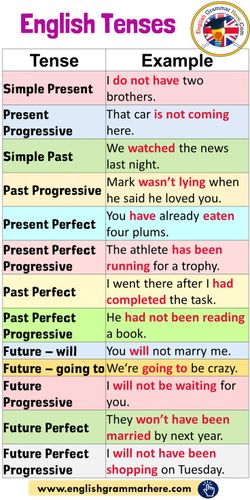
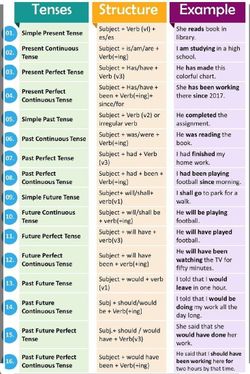
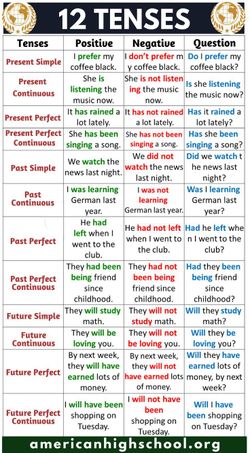
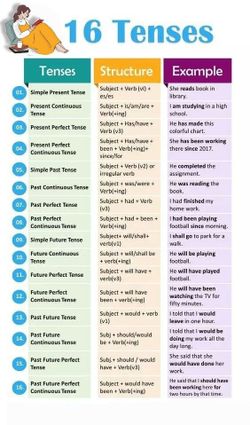
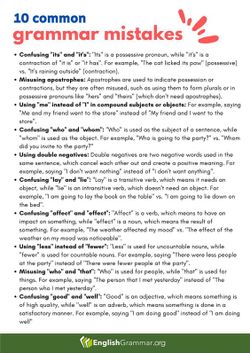

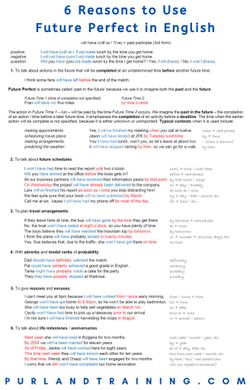

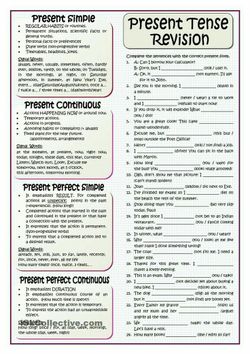
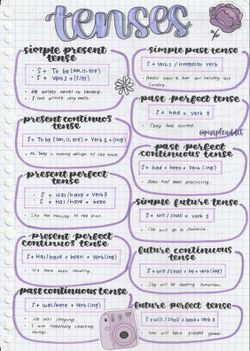
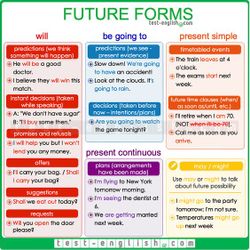

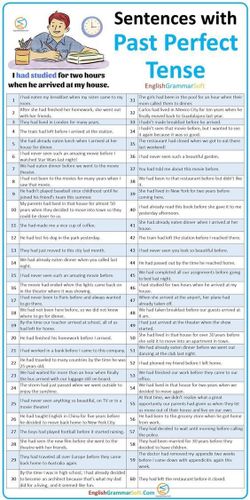
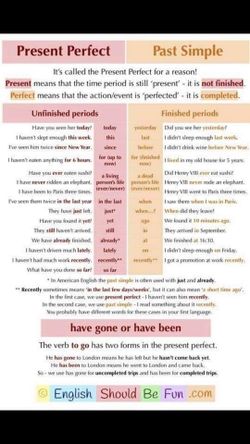
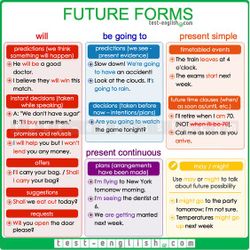
By undefined
40 notes ・ 3 views
English
Intermediate